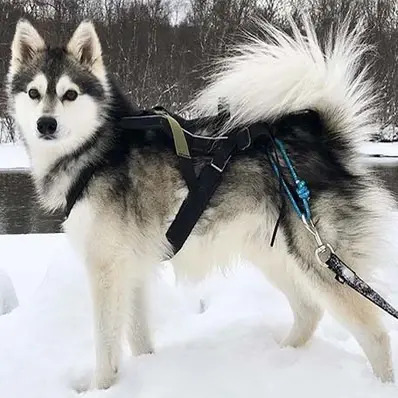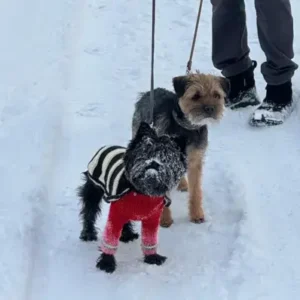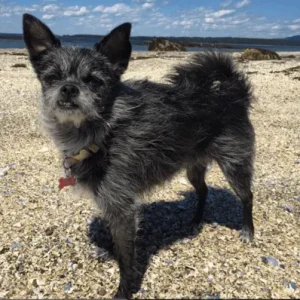Alaskan Klee Kai History/Origin
The Alaskan Klee Kai traces its lineage back to the ancient native dogs that have roamed Alaska for millennia. These purebred dogs were more than just pets; they were vital to survival in Alaska’s harsh conditions, aiding tribal and nomadic groups by pulling sleds, hiking, hunting, tracking, and serving as early warning systems for dangers like wild animals or intruders.
The Alaskan Interior Village dogs, a key component of what became the Alaskan Husky type, contributed significantly to this lineage. In the early 1900s, Alaskan Huskies were further enriched with Siberian Husky bloodlines, leading to a breed renowned for its intelligence, energy, and work ethic.
The Alaskan Klee Kai we know today was developed in Alaska by Linda Spurlin and her family beginning in the early 1970s. Through a meticulous breeding program, they aimed to create a smaller, companion-sized version of the Alaskan Husky with distinctive symmetrical facial markings and a robust health profile.
True to their heritage, Alaskan Klee Kais are versatile and adaptable, thriving in various roles such as travel companions, hiking partners, sports enthusiasts, therapy dogs, and, most importantly, loving family pets for all ages.
Alaskan Klee Kai Personality
The Alaskan Klee Kai is one of the dog breeds that is a loving companion to its human family, though it may sometimes appear aloof. With its sharp intelligence, this breed is highly trainable and eager to please. The Klee Kai can get along with cats, especially if they’ve been raised together.
- Potential Challenges
While a wonderful companion, the Alaskan Klee Kai presents some challenges. Its small size, while charming, limits its effectiveness as a guard dog compared to larger breeds. The Klee Kai’s high energy and intelligence require ample exercise and mental stimulation to prevent boredom.
Additionally, this breed can be somewhat aloof with strangers and may be prone to vocalizing its displeasure, which can be a bit of a nuisance. Socialization is crucial, especially with other pets like cats, as the Klee Kai might be rough with them if not introduced properly. Managing these aspects will ensure a happy and well-adjusted Alaskan Klee Kai.
Alaskan Klee Kai Physical Appearance
The Alaskan Klee Kai features a well-balanced and proportionate physique. It has a distinctive wedge-shaped head, a slightly curled tail, and triangular ears. The breed’s eyes can be brown, blue, or amber, complementing its wide, black nose.
- Size
The Alaskan Klee Kai is a small dog that usually stands between 12 and 17 inches tall. Its weight varies from 6 to 25 pounds, depending on the individual dog’s size and build.
- Coat color
The Alaskan Klee Kai is recognized in three standard coat colors: red and white, black and white, and gray and white. Although solid white coats are also seen, these dogs typically have either a standard or full coat. Both coat types are double-layered, featuring a soft undercoat and a longer, coarser outer coat that protects against harsh weather conditions.
Light brown Alaskan Klee Kai- Source: AKC.org
Brown and White Alaskan Klee Kai- Source: AKC.org
Black and White Alaskan Klee Kai- Source: alaskankleekai
Alaskan Klee Kai Gender Differences
In the Alaskan Klee Kai breed, the main difference between genders is size, with males typically being about 4 inches taller than females. Aside from this size variation, there are no significant personality differences between males and females. Both genders exhibit similar traits and temperaments.
Alaskan Klee Kai Feed/Nutrition
To keep your Alaskan Klee Kai well-nourished, feed them raw dog food twice daily—morning and evening. Adding sardines to their diet at least three times a week can be beneficial. Additionally, offer raw organic meat such as liver, heart, or kidney once a week.
As high-energy dogs, Klee Kais need a diet that supports their active lifestyle. Ripe tomatoes can be given in moderation as treats, providing vitamins, but remove stems and leaves, which can be toxic.
While their energy levels help prevent excessive weight gain, proper nutrition is essential for their overall health. For tailored dietary advice, consult your veterinarian or a professional nutritionist.
Alaskan Klee Kai Health
The Alaskan Klee Kai breed is typically recognized for its strong health and low incidence of genetic problems. However, owners should remain aware of certain medical conditions to which the breed is prone, including:
- Patellar Luxation: This occurs when the kneecap dislocates from its usual position, causing pain and difficulty walking. To prevent this, ensure regular vet check-ups to catch early signs and maintain a healthy weight for your Alaskan Klee Kai. Avoid high-impact activities that could strain the joints.
- Autoimmune Thyroiditis: It is a condition where the immune system attacks the thyroid gland, leading to hypothyroidism with symptoms like lethargy and skin issues. Preventive measures include regular thyroid function tests and a balanced diet. Consult your vet if any symptoms arise.
- Heart Murmur: It is an abnormal sound during a heartbeat that can indicate heart disease, potentially causing coughing or exercise intolerance. Regular vet check-ups and heart screenings are essential for early detection. Maintaining a healthy weight and providing appropriate exercise can support heart health.
- Eye Issues: In Alaskan Klee Kais can include cataracts and progressive retinal atrophy (PRA), affecting vision. Regular eye exams by a veterinarian are crucial for monitoring eye health. Protect your dog from excessive sun exposure and provide a balanced diet to support eye health.
- Factor VII Deficiency: This is a rare bleeding disorder where the blood lacks clotting factor VII, making it difficult to stop bleeding and leading to excessive bruising. Early diagnosis through blood tests is important, and avoiding activities that could cause injury is recommended. Consult your vet for management and treatment options.
Alaskan Klee Kai Care and Grooming
Caring for an Alaskan Klee Kai involves ensuring their exercise needs are met, as they can become high-strung and anxious without sufficient activity. Regular care includes brushing their teeth, clipping their nails, and cleaning their ears, so consulting your veterinarian about their specific needs is recommended.
Unlike many breeds, Alaskan Klee Kais typically do not develop a dog odor and tend to groom themselves, so they may not require frequent baths. However, they will need regular brushing during coat-shedding seasons, which occur before summer and winter.
During these times, they shed heavily, while shedding is moderate throughout the rest of the year. Additionally, training your dog not to bite should start early, as it’s an important part of managing their behavior, especially during times of heightened energy.
Alaskan Klee Kai Rescue Groups
If you’re considering adopting an Alaskan Klee Kai, checking with breed-specific rescue groups can be a great way to find a loving companion. These organizations specialize in rescuing and rehoming Klee Kais, giving them a second chance at a happy life. They can offer valuable insights into the breed and help match you with a dog that suits your lifestyle.
Alaskan Klee Kai Price
The price of an Alaskan Klee Kai typically ranges from $2,500 to $3,000, depending on factors such as breeder reputation, pedigree, and location.
When looking to purchase an Alaskan Klee Kai, it’s crucial to choose a reputable breeder who prioritizes health, proper socialization, and adherence to breed standards. Ethical breeders focus on the well-being of their dogs and conduct thorough health screenings.
Interesting Facts
- Vanessa Hudgens has been seen with her Alaskan Klee Kai in social media posts.
Vanessa Hudgens- Source: Pinterest
- The Alaskan Klee Kai can also have unique eye variations, such as bi-eyes (each eye a different color) or parti-eyes (two colors within the same eye).
Best For
The Alaskan Klee Kai is best suited for active individuals or families who can meet their high energy and exercise needs. They thrive with owners who can provide regular physical activity and mental stimulation. This breed is also a good fit for those who appreciate a smaller, intelligent dog with a strong personality. They adapt well to a variety of lifestyles but require dedicated care and attention to stay happy and healthy.
Top Names
| Male Alaskan Klee Kai Names | Female Alaskan Klee Kai Names |
| Max | Bella |
| Loki | Luna |
| Diesel | Zoe |
| Rex | Mia |
| Jasper | Daisy |











 Light brown Alaskan Klee Kai- Source:
Light brown Alaskan Klee Kai- Source:  Brown and White Alaskan Klee Kai- Source:
Brown and White Alaskan Klee Kai- Source:  Black and White Alaskan Klee Kai- Source:
Black and White Alaskan Klee Kai- Source: 








